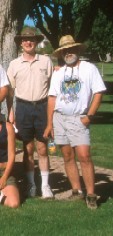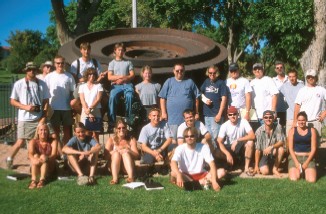In that first year with George in 1997, I was given the responsibility of teaching physical geography to the field class. You see, there are ideally two faculty members who co-teach this course, as it’s just too much to handle for one person: driving the vans, preparing and grading assignments, intensive time management while in the field and away from home, and constantly keeping the students busy with relevant activities and discussions. In short, there is much to do and much to keep track of. It is tiring, but rewarding. It’s also a great excuse to travel with the students and to see new places and to revisit others.
The challenge for me in 1997 was not only that of being a “rookie,” but also involved my teaching assignment. George and I had similar research and teaching interests in human geography rather than with physical processes, and so George focused on teaching “human” while I was expected to teach “physical”. This was no doubt a task for me, in that I had only been in Flagstaff and the Southwest for one year and was not familiar with the region all that well. Although I had experience teaching introductory physical geography and weather and climate, I still had to be self-taught about this fascinating and diverse region. In the months preceding that course, therefore, I purchased and read a good number of local and regional books about the physical geography and environments of the Southwest. It paid off! I still use many of these sources for reference. It was a great learning experience for me, and it motivated me to learn about the physical landscapes and climate of the region. During my first year at NAU, therefore, I had taught more physical geography than human, despite my training as an urban/cultural/historical geographer. Even faculty members in the department had come to think of me as a “physical geographer,” and I recall numerous times trying to explain to people, “I’m really not a physical geographer, I just play one on TV”. That phrase seemed to work pretty well, and I still use it occasionally.
Things changed, however, when the new Department chair, Dr. Bob Clark, put me in charge of the field class for 1999, stating that it was basically up to me to decide with whom I wanted to teach. Once decided, I had to convince that person to teach it! I recall that nobody really wanted to teach the field class at first, although one faculty member was willing to do it if no one else would. When I first asked Dr. Lee Dexter, he flatly refused, claiming to not have enough time. Well, times have changed. After I had asked him to teach it with me and after his quick refusal, he came back to my office with second thoughts. He wanted to see a syllabus from the previous year, and upon seeing it, he instantly became enthused about the whole idea. He agreed to teach it, and since then his enthusiasm has only increased. Thank heavens! He is perfect for the class, and he probably has much more field experience than anyone in that department. Winter road
 trips
with his “Snow and Ice” class to Silverton, Colorado with a legion of students
is typical of what he is used to. Thus, since 1999 Lee has been primarily
responsible for the physical geography while I focus on human topics.
Both of us are reasonably proficient in the other’s specialty though, so
occasionally we “cross over” and teach something that is generally outside
our primary interests. And that’s a good thing, because the physical
and human environments are closely intertwined and impact one another.
That very fact is a primary lesson for the students throughout the course:
the interrelationships between the human and physical environments.
So, it’s a good match with the two of us teaching the course, and I was
pleased to have several students tell me that during our last camping trip
this year. Despite very different backgrounds and interests, Lee
and I both maintain similar teaching styles, standards, and strategies,
and we both like to be well organized. This past May, 2001, was our
third annual – and I think our most well managed – field course.
We are already discussing possible road trips for next year. As a
hint, if any students are reading this, we are seriously contemplating
a four-day trek into southern New Mexico, or into southern Colorado.
I also have “eyes” for California in future years.
trips
with his “Snow and Ice” class to Silverton, Colorado with a legion of students
is typical of what he is used to. Thus, since 1999 Lee has been primarily
responsible for the physical geography while I focus on human topics.
Both of us are reasonably proficient in the other’s specialty though, so
occasionally we “cross over” and teach something that is generally outside
our primary interests. And that’s a good thing, because the physical
and human environments are closely intertwined and impact one another.
That very fact is a primary lesson for the students throughout the course:
the interrelationships between the human and physical environments.
So, it’s a good match with the two of us teaching the course, and I was
pleased to have several students tell me that during our last camping trip
this year. Despite very different backgrounds and interests, Lee
and I both maintain similar teaching styles, standards, and strategies,
and we both like to be well organized. This past May, 2001, was our
third annual – and I think our most well managed – field course.
We are already discussing possible road trips for next year. As a
hint, if any students are reading this, we are seriously contemplating
a four-day trek into southern New Mexico, or into southern Colorado.
I also have “eyes” for California in future years.
[Photo: Instructors Tom Paradis, left, and Lee Dexter at Boulder City, NV. Photo by Colby Davis]
What follows are some of the highlights of Field Class 2001, written here as a sort of “memoir” of the entire experience. Aside from the places visited this year, it was most interesting to observe the students on our various expeditions. Here, I write about some of these very observations from my perspective as a teacher and geographer. Names of students here are fictitious to avoid any potential embarrassment and law suits. Rather than simply a sequential “travel log,” however, the stories below are based more on specific topics of experiences. Further, this is not a geography lesson; instead, I have written these memoirs with a focus on the social interactions within the class and the interesting experiences that occurred at various times and places along the way. These are the types of things that – beyond the geography – both the students and professors will perhaps remember for years down the road. It is important to note that the stories below do not necessarily coincide with the sequence of trips that we took, and they are written from my own perspective only. Further, you would likely hear very different perspectives from each person who accompanied us. Still, this is my own version, from the teacher’s view – essentially a sneak peak, “behind the scenes,” of Field Class 2001. Enjoy!
